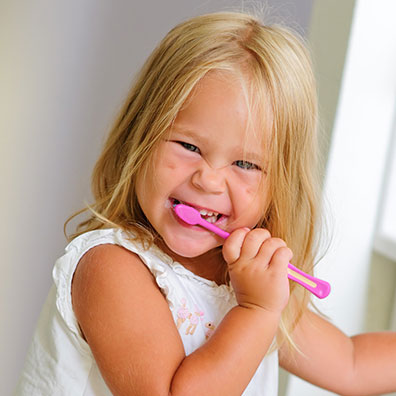Preventive Care
Preventing Problems Before They Start
The health of your child’s teeth and mouth is very important to the well-being of his or her entire body, and while routine brushing and flossing at home is necessary to keep your child’s smile looking its best, visiting the dentist for a comprehensive exam and cleaning is essential. The American Dental Association recommends that your child visit the dentist every six months to ensure his or her teeth stay healthy and smile stays beautiful.
By routinely seeing the dentist for exams and cleanings, your child can:
- Prevent tooth decay, gum disease, and bad breath
- Avoid costly and extensive dental procedures
- Have white teeth by reducing staining from food and drinks
- Shorten the time spent in the dentist’s office
- Have a smile that will last a lifetime
The Exam
During your child’s exam, the dentist will thoroughly examine your child’s teeth and gums for signs of tooth decay, gum disease, and other health problems. The dentist may also want to take X-rays to see what is happening beneath the surface of the teeth and gums. Whether these X-rays are traditional or digital, the images provided will help the dentist discover dental issues not visible to the naked eye.
Professional Cleanings
The dental hygienist will begin your child’s cleaning by exploring the surface of the teeth to determine if there are any cavities and to examine the quality of existing fillings. The dental hygienist will then perform a periodontal exam to make sure your child’s gums adhere tightly to the teeth, and no periodontal disease or bone loss is present.
Next, the hygienist will carefully clean your child’s teeth with a variety of tools to remove any hard mineral buildup (tartar) from the teeth. Then, the hygienist will floss your child’s teeth, use a polishing compound, and apply fluoride. Cleanings usually aren’t painful, but if your child has any anxiety about the dental exam, be sure to let the hygienist know. They may offer several sedation options to ensure your child’s comfort. If the dentist or hygienist finds tooth decay or gum disease, they will talk to you about changing your child’s brushing or flossing habits. In severe cases, they may recommend antibiotics or other dental treatments. If your child’s teeth and gums appear to be healthy, the dentist will probably recommend that your child continue his or her brushing and flossing routine as usual.
Preventive dental care is important throughout life, especially at a young age. By practicing good oral hygiene at home and scheduling regular checkups with the dentist, your child can help keep their smile bright and healthy for many years to come. Here are a few simple ways to prevent the build-up of plaque and cavities:
- Make sure your child brushes their teeth at least twice a day with a soft-bristled toothbrush. Use fluoride toothpaste to remove food particles and plaque from the tooth surfaces. Also be sure your child brushes the top surface of the tongue; this will remove any extra plaque-causing food particles and help keep their breath fresh!
- Make sure your child cleans between teeth by flossing at least once a day. You can also use a mouthwash to help kill bacteria and freshen breath. Decay-causing bacteria can linger between teeth where toothbrush bristles can't reach. Floss and mouthwash will help remove plaque and food particles from between the teeth and under the gum line.
- Make sure your child eats a balanced diet, and try to avoid extra-sugary treats. Nutritious foods such as raw vegetables, plain yogurt, cheese, or fruit can help keep your child's smile healthy.
- Remember to schedule regular checkups with your child’s dentist every six months for a professional teeth cleaning.
- Ask your dentist about dental sealants, a protective plastic coating that can be applied to the chewing surfaces of the back teeth where decay often starts.
- If your child plays sports, be sure to ask your dentist about special mouthguards designed to protect your child’s smile.
- Brushing Instructions
-
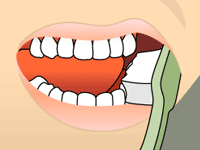
Brushing: Step 1
Place your toothbrush at a 45-degree angle to your gum.
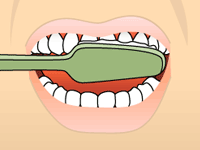
Brushing: Step 2
Brush gently in a circular motion.
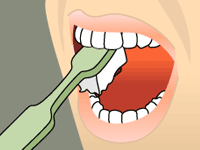
Brushing: Step 3
Brush the outer, inner, and chewing surfaces of each tooth.

Brushing: Step 4
Use the tip of your brush for the inner surface of your front teeth.
- Flossing Instructions
-

Flossing: Step 1
Wind about 18 inches of floss around your fingers as shown. Most of it should be wrapped around one finger, and the other finger takes it up as the floss is used.
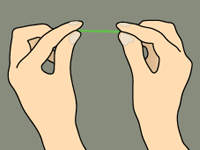
Flossing: Step 2
Use your thumbs and forefingers to guide about one inch of floss between your teeth.

Flossing: Step 3
Holding the floss tightly, gently saw it between your teeth. Then curve the floss into a C-shape against one tooth and gently slide it beneath your gums.

Flossing: Step 4
Slide the floss up and down, repeating for each tooth.
If it’s been six months or more since your child’s last dental checkup, then it’s time to contact our practice and schedule an appointment!

